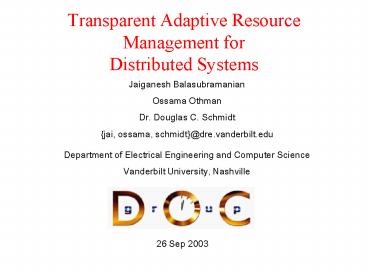Transparent Adaptive Resource Management for Distributed Systems PowerPoint PPT Presentation
Title: Transparent Adaptive Resource Management for Distributed Systems
1
Transparent Adaptive Resource Management
forDistributed Systems
Jaiganesh Balasubramanian Ossama Othman Dr.
Douglas C. Schmidt jai, ossama,
schmidt_at_dre.vanderbilt.edu
Department of Electrical Engineering and Computer
Science Vanderbilt University, Nashville
2
Distributed Systems
- Typical issues with distributed systems
- Heterogeneous environments
- Concurrency
- Large bursts of client requests
- 24/7 availability
- Stringent QoS requirements
- Examples of distributed systems
- E-commerce
- Online trading systems
- Mission critical systems
- Defense
- Ship systems
3
Motivation
- Development and maintenance of QoS-enabled
distributed systems - Non-trivial
- Requires expertise that application developers
often lack - Solution Middleware (e.g. CORBA)
- Can shield distributed system developers from the
complexities involved with developing distributed
applications - Can facilitate manipulation of QoS requirements
and management of resources
4
Distributed System Resource Management
- Middleware can alleviate resource management
difficulties - Doing so in a transparent and efficient manner is
difficult - Managing resources transparently is important for
legacy DRE systems - Often cannot be easily modified to introduce
support for improved distributed resource
management - May not be feasible to do so
- Middleware in use may need to be enhanced to
support this functionality - Such an enhancement can be found in a
middleware-based load balancing service
5
Middleware-Based Load Balancing
- Load balancing service can be used to manage
resources for middleware-based distributed
systems - Can improve the efficiency and overall
scalability of a distributed system - Allows additional components to be added to
distributed systems with minimal impact to
performance - Improves availability due to inherent redundancy
- Can be composed with other services (e.g. fault
tolerance, security, etc) - Can take into account request content
6
Basic Scenario
- Multiple clients making request invocations
- Potentially non-deterministic
- Members
- Multiple instances of the same object
implementation - Object groups
- Collections of members among which loads will be
distributed equitably - Logically a single object
- Load balancer
- Transparently distributes requests to members
within an object group
7
TAO Load Balancer (Cygnus)
- Cygnus makes it easier to develop distributed
applications in heterogeneous environments
providing application transparency, scalability,
flexibility, adaptability and interoperability. - Uses the following strategies
- - RoundRobin
- - Random
- - LeastLoaded
8
Load Balancing Strategies
- Client binding granularity
- Per-session
- Client permanently forwarded to a replica
- Per-request
- Requests forward on clients behalf
- On-demand
- Client can be rebound to another replica whenever
necessary - Balancing policy
- Non-adaptive
- No load feedback used when binding clients
- Adaptive
- Load feedback taken in to account
9
Load Balancing Architectures
- Load balancing architecture comprised of a
combination of client binding granularity and
balancing policy - Given the strategies just described, there are
six possible architectures - Three common architectures
- Non-adaptive per-session
- Adaptive per-request
- Adaptive on-demand
10
Load Balancer Components
- Load Monitor
- Provides load feedback
- Load Analyzer
- Determines location and member load conditions
- Member Locator
- Binds client to appropriate object group member
- Load Alert
- Facilitates load control (load shedding)
- Load Manager
- Mediates all interactions between load balancer
components
11
Load Monitor
- Facilitates feedback
- Monitor and report loads
- Load monitoring is location-oriented
- The loads at a given location are monitored and
reported - Contrast with loads on a given object group
member
12
Load Analyzer
- Load Analyzer
- Decides which member will receive the next client
request - Determines load condition at each location
- Induces load shedding
- Extensible load balancing strategies
- Set via the PropertyManager interface
- Each object group may use a different strategy
13
Member Locator
- Implements the Interceptor design pattern
- Transparently forwards client requests to member
retrieved from the load analyzer - In CORBA, redirection induced via standard GIOP
LOCATION_FORWARD message - Conforming client side ORB will transparently
re-issue request to member chosen by load
balancer
14
Load Alert
- Facilitates control aspect of load balancing
- Load shedding
- Only used for adaptive load balancing strategies
- Forwards client requests back to load balancer
15
Load Manager
- Mediates interactions between all load balancer
components - Manages object groups
- Manages load monitor and load alert location maps
- Acts as a specialized event channel
- Load events are published by load monitors
- Load events are consumed by load analyzers
16
Load Balancing Instructions
17
Future Work
- Define stateful load balancing model
- Decentralized load balancing
- Reduced network overhead
- Improved reliability
- Integrate multicast support
- Examine compatibility with real-time systems
- Examine similarities and parallels to dynamic
scheduling
18
Concluding Remarks
- Load balancing architecture and model is
- Flexible
- Extensible load balancing strategies
- Allows both non-adaptive and adaptive (including
self-adaptive) strategies to be used - Freedom to implement in a variety of ways
- Centralized
- Decentralized / Federated / Cooperative
- Hierarchical
- Generic
- Supports multiple object groups
- Not application-specific
- Familiar
- Uses many of the same group management concepts
found in existing fault tolerance models
19
References
- Ossama Othman, Jaiganesh Balasubramanian, Douglas
C. Schmidt - The Design of an Adaptive Load Balancing
and Monitoring Service - http//www.cs.wustl.edu/schmidt/IWSAS_2003.p
df - Ossama Othman, Jaiganesh Balasubramanian, Douglas
C. Schmidt - Performance Evaluation of an Adaptive Load
Balancing and Monitoring Service - http//www.cs.wustl.edu/schmidt/ICDCS_2004.p
df

